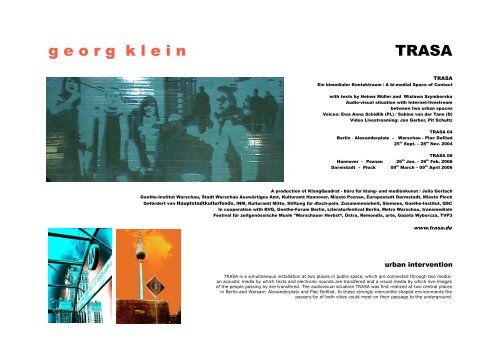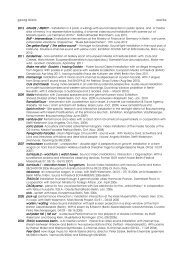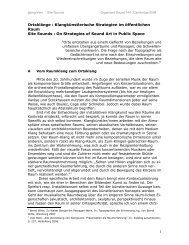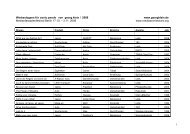Klang – Tod – Bewegung - Georg Klein
Klang – Tod – Bewegung - Georg Klein
Klang – Tod – Bewegung - Georg Klein
Create successful ePaper yourself
Turn your PDF publications into a flip-book with our unique Google optimized e-Paper software.
g e o r g k l e i n TRASA<br />
TRASA<br />
Ein bimedialer Kontaktraum / A bi-medial Space of Contact<br />
with texts by Heiner Müller and Wislawa Szymborska<br />
Audio-visual situation with Internet-livestream<br />
between two urban spaces<br />
Voices: Ewa Anna Schidlik (PL) / Sabine von der Tann (D)<br />
Video Livestreaming: Jan Gerber, Pit Schultz<br />
TRASA 04<br />
Berlin - Alexanderplatz <strong>–</strong> Warschau - Plac Defilad<br />
25 th Sept. <strong>–</strong> 28 th Nov. 2004<br />
TRASA 06<br />
Hannover <strong>–</strong> Poznan 26 th Jan. <strong>–</strong> 26 th Feb. 2006<br />
Darmstadt <strong>–</strong> Plock 09 th March <strong>–</strong> 09 th April 2006<br />
A production of <strong>Klang</strong>Quadrat - büro für klang- und medienkunst / Julia Gerlach<br />
Goethe-Institut Warschau, Stadt Warschau Auswärtiges Amt, Kulturamt Hannover, Miasto Poznan, Europastadt Darmstadt, Miasto Plock<br />
Gefördert von Hauptstadtkulturfonds, INM, Kulturamt Mitte, Stiftung für dtsch-poln. Zusammenarbeit, Siemens, Goethe-Institut, QSC<br />
In cooperation with BVG, Goethe-Forum Berlin, Literaturfestival Berlin, Metro Warschau, transmediale<br />
Festival für zeitgenössische Musik "Warschauer Herbst“, Üstra, Remondis, arte, Gazeta Wyborcza, TVP3<br />
www.trasa.de<br />
urban intervention<br />
TRASA is a simultaneous installation at two places in public space, which are connected through two media:<br />
an acoustic media by which texts and electronic sounds are transfered and a visual media by which live-images<br />
of the people passing by are transfered. The audiovisual situation TRASA was first realized at two central places<br />
in Berlin and Warsaw: Alexanderplatz and Plac Defilad. In these strongly mercantile shaped environments the<br />
passers-by of both cities could meet on their passage to the underground.
g e o r g k l e i n TRASA<br />
visual interaction<br />
The passage halls lead directly to a wall above a staircase. There a camera was installed which<br />
filmed the people from a frontal perspective. These images were projected on the wall and at<br />
the same time streamed to the other city. The image of the other city was projected directly<br />
next to the own mirrow-image. People of one urban space faced people of the other urban<br />
space <strong>–</strong> and at the same time regarded theme-selves. Perception of the others and oneself in a<br />
simultaneous process.<br />
time delay<br />
The streaming caused a delay of approx. 2 sec. in the video-projection at the distant place. The local images were delayed as<br />
well so one would percept oneself with a shift in time. This phenomenon motivated the visitors of the installation to extensively<br />
explore the interactions with themsel-ves before noticing the second part of the image with people from the other city. The<br />
emerging manners to comunicate through gestures and body-language varied vastly and ranged from dumb standing face to<br />
face to political demonstrations.<br />
visual estrangement<br />
By estranging the images into a grey shaded image, rich in contrasts and blurred, differences of age, class, nationality and gen -<br />
der were smoothed out. One would face another person without making out who he was. Even oneself was a stranger. Because<br />
the images were projected directly on the walls <strong>–</strong> in Berlin the walls were covered with greenish tiles <strong>–</strong> they were even less clear.<br />
The wall became a window which offered insight into a remote urban space.<br />
virtuelle grenzen<br />
The perspective of the camera aimed to show the long passage and the passersby<br />
approaching the image. Just before the downgoing staircase they reached full<br />
body size. Because of the borders of the image people could suddenly enter and<br />
leave the image or they could play with the border between the two images from<br />
Berlin and Warsaw, could merge or touch each other virtually.<br />
2
g e o r g k l e i n TRASA<br />
acoustical topography of text<br />
musical text interaction<br />
Within the visual constellation a spacial track was defined by a sensor (laser). Moving on it made audible two poems , in Berlin<br />
the poem ... by Heiner Müller, in Warsaw „Bahnhof“ von Wislawa Szymborska <strong>–</strong>. (see the yellow line TRASA-TEXT).If a person<br />
stepped into a certain spot of the track the assigned text would start in a musical ornamentation. Thus the text could be physi -<br />
cally crossed and experienced according to the own position.<br />
interactive text loops<br />
The position of the person initiated a loop and at the same time a process of variation of this loop. Similar to the method of gra -<br />
nular synthesis the position and the length of the time-frame resp. the loop was variable. Through this artistic strategy smooth<br />
transitions were created as well as new combinations of text-fragments and thus a new meaning (s. moving text window).<br />
generating a common sound space<br />
The varying text-loops would be spacialized by 10 to 16 red loudspeakers. While the people in Warsaw determined the polish<br />
text the germans determined the german text structure. The data was transfered simultaneously so both texts (and both „move -<br />
ments“) could be heard at both locations. The languages were mixed to a common sound space of comprehensible and uncom -<br />
prehensible speech.<br />
poetic reflection<br />
The content of the poems reflected the real situation: meeting and not-meeting. Both poems talk about something missing. In<br />
the audio-visual situation people in both cities could see but not touch each other, could not talk and listen directly but hear the<br />
other language. The intimacy of the poem was in harsh contrast to the anonymity of the urban situation. In addition utopic<br />
thoughts are articulated in the poems: Szymborska: „In the paradise lost of probalitity. Somewhere else. Somewhere else. How<br />
these little words ring.“ Müller: „The angel I hear him still. Although he no longer has a face“. Both poets end with an acoustic<br />
metaphor for the loss of utopy.<br />
artistic director: georg klein<br />
producing director : julia gerlach<br />
catalog TRASA warszawa-berlin, Kehrer-Verlag<br />
video documentation 8min. (short) / 29min. (full), germ./engl.<br />
3






